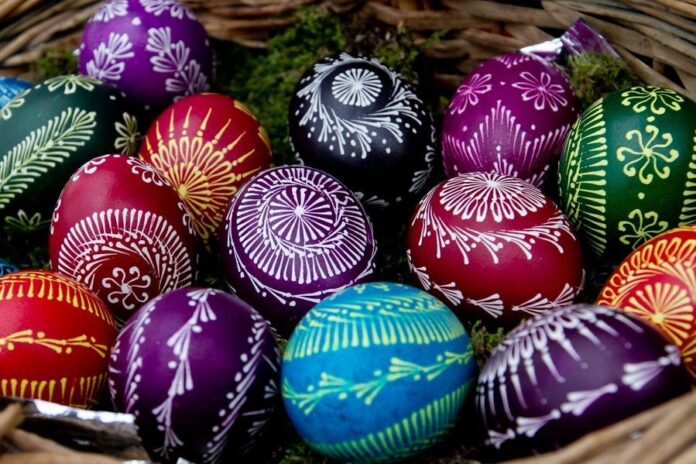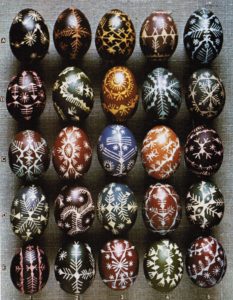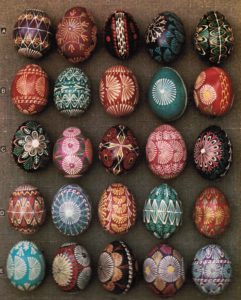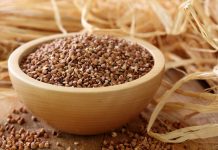
Is it too early to think about decorating Easter eggs? Easter Sunday is only 5 weeks away!
This year, due to the pandemic, you may have more time to spend at home decorating Easter eggs in the Lithuanian folk-art tradition. All it takes is patience and practice!
There are two ways Lithuanians traditionally decorate Easter eggs, both involving dye: the scratch method and the wax (batik or resist) method. The founder of the Lithuanian Folk Art Institute (LTFAI), Antanas Tamošaitis, compiled an entire book called Easter Eggs, published by the institute in 1982. It contains a vast variety of patterns to inform and inspire everyone from amateur to artist.
EGG DYES
Most of us rely on the simple dyes sold in supermarkets before Easter each year, and these are certainly adequate. The brighter or deeper the colour, the more attractive the patterns will be on the finished egg. There are many “folk” ways to dye eggs using natural materials, some of which are detailed on the LTFAI website, https://ltfai.org. Generally, to intensify the colour, the eggs must be immersed in dye for quite a long time. Regular dyes can be doubled or mixed to obtain more intense or unusual colours.
Experts tell us to use smooth eggs for best colour, handle them with very clean hands, and lift them out of the dye carefully and pat dry to avoid any unwanted marks.

SCRATCH METHOD
The scratch method is easier, because all you need is a dyed egg (the darker the colour, the better the designs will show) and a pocket-knife or a paring knife, or any utensil you may find handy to hold like a pencil. Scratch patterns are infinite in their variety and can be drawn on the egg beforehand, or created as you work. Here are some examples from Tamošaitis’ book. Sit back, relax, and don’t rush. This is a labour of love, so start thinking about it well before Easter!
WAX METHOD
There are endless beautiful patterns to make with the wax method. It may require a bit more practice to perfect the strokes, which are a slender teardrop shape. The eggs should be boiled with a generous pinch of salt to avoid breakage. White eggs, though more fragile, provide a better background for most patterns than brown eggs.
The resist method requires starting with an undyed or dyed egg, applying wax, then dyeing it again in another colour. The colour beneath the wax will show through once the wax is removed. Two or three layers of colour can be achieved this way before removing the wax. For additional colour, wax crayons may be added to the beeswax.
You will need some beeswax. Paraffin is not suitable, as it will not adhere properly to the egg. You will need a container such as a jar lid or tea light holder for the wax, set on a source of heat below to keep the wax liquid. This can be a candle enclosed in a holder that is vented at the sides (such as a small cemetery candle or aromatherapy container). For a group, the wax can be divided among tinfoil tart pans, and warmed by setting in an electric frying pan. This can be more difficult with younger children, because participants’ hands must be close to the hot wax container.

The most widely used instrument for making the characteristic dots and strokes is a metal, flat-headed (sewing) pin with its point firmly inserted into the eraser end of a pencil. A tiny-headed nail may also be used. Holding the pencil pin side down, the pin is dipped into the hot wax, and a dot of wax is applied to a (room temperature or ideally still-warm) egg. To make the slender teardrop strokes, drag the pin from the dot in a straight or curved line in the direction required by the pattern.
Once the desired pattern is completed, allow the wax to dry completely for several hours or overnight. Remove the wax by scraping gently, using a thumbnail or warm cloth. Smoothing the wax over the egg to coat it will also shine the shell, enhancing the colours, and make it stronger.
DYES
There are many recipes to experiment with using natural materials such as berries, vegetables, onion skins, teas and even spices, especially turmeric.
For a deep blue colour, heat frozen blueberries or 200-250 grams of blueberry jam, in ½ litre of water with 1 tablespoon of vinegar. Strain the mixture to prevent particles on the eggs. Immerse boiled eggs for ½ hour for a pastel colour, or 4-5 hours for a deep, rich colour. Check periodically for intensity and remove eggs when they have reached the desired hue, allow to dry without patting or rubbing. Once dry, apply oil to make the eggs shine.
A rich yellow colour can be produced by boiling turmeric with ½ litre of water. Strain to remove lumps, add vinegar and immerse boiled eggs in the liquid for 3 hours. To attain a mossy green colour put turmeric-dyed eggs into purple cabbage dye for ten minutes.
For instructions and recipes using natural dyes, please visit the Lithuanian Folk Art Institute website https://ltfai.org.
For traditional onion-skin dyeing, fill a pot ¾ full with loose onion skins (not tamped down). Nestle the eggs in the pot so they are completely enveloped in the skins. Cover with warm water and leave at room temperature overnight. In the morning, add (1 tablespoon) vinegar, heat to boiling, then let the pot simmer for 10 minutes. Allow the eggs to stand for ½ hour. Remove from the pot while they are still warm.
Traditional patterning of the onion-dyed eggs is achieved by moistening the egg surface slightly with water or egg white and pressing on leaves, petals or grass-blades, wrapping the egg in onion skins, and then tying the bundled egg into a cheesecloth or a tube cut from nylon hosiery to keep the leaves and skins from falling away during boiling.
Finally, a surprising dye effect can be achieved with wine. Use one bottle of semi-sweet wine for a dozen eggs. Boil eggs in the wine in a shallow pan for 10 minutes and keep them at room temperature for 12 hours. Apparently, they sparkle!
Send us your favourite Easter egg tricks to [email protected], together with any recipes you would share online!
Photos from Lithuanian Easter Eggs by Antanas Tamošaitis






























